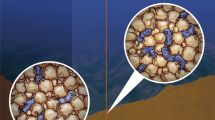Abstract
Detection of sulfur-oxidizing bacteria has largely been dependent on targeted gene sequencing technology or traditional cell cultivation, which usually takes from days to months to carry out. This clearly does not meet the requirements of analysis for time-sensitive samples and/or complicated environmental samples. Since energy-dispersive X-ray spectrometry (EDS) can be used to simultaneously detect multiple elements in a sample, including sulfur, with minimal sample treatment, this technology was applied to detect sulfur-oxidizing bacteria using their high sulfur content within the cell. This article describes the application of scanning electron microscopy imaging coupled with EDS mapping for quick detection of sulfur oxidizers in contaminated environmental water samples, with minimal sample handling. Scanning electron microscopy imaging revealed the existence of dense granules within the bacterial cells, while EDS identified large amounts of sulfur within them. EDS mapping localized the sulfur to these granules. Subsequent 16S rRNA gene sequencing showed that the bacteria detected in our samples belonged to the genus Chromatium, which are sulfur oxidizers. Thus, EDS mapping made it possible to identify sulfur oxidizers in environmental samples based on localized sulfur within their cells, within a short time (within 24 h of sampling). This technique has wide ranging applications for detection of sulfur bacteria in environmental water samples.
Similar content being viewed by others
References
Amann R I, Ludwig W, Schleifer K H. 1995. Phylogenetic identification and in situ detection of individual microbial cells without cultivation. Microbiol. Rev., 59(1): 143–169.
Eder S H K, Gigler A M, Hanzlik M, Winklhofer M. 2014. Sub-micrometer-scale mapping of magnetite crystals and sulfur globules in magnetotactic bacteria using confocal raman micro-spectrometry. PLoS One, 9(9): e107356, http://dx.dox.org./10.1371/journal.pone.0107356.
Fischer C, Wiggli M, Schanz F, Hanselmann K W, Bachofen R. 1996. Light environment and synthesis of bacteriochlorophyll by populations of Chromatium okenii under natural environmental conditions. FEMS Microbiol. Ecol., 21(1): 1–9.
Franz B, Lichtenberg H, Hormes J, Modrow H, Dahl C, Prange A. 2007. Utilization of solid ‘elemental’ sulfur by the phototrophic purple sulfur bacterium Allochromatium vinosum: a sulfur K-edge X-ray absorption spectroscopy study. Microbiol ogy, 153(4): 1268–1274.
Gervais F. 1997. Diel vertical migration of Cryptomona s and Chromatium in the deep chlorophyll maximum of a eutrophic lake. J. Plankton Res., 19(5): 533–550.
Hageage G J, Gherna R L. 1971. Surface structure of Chromatium okenii and Chromatium weissei. J. Bacteriol., 106(2): 687–690.
Jogler C, Niebler M, Lin W, Kube M, Wanner G, Kolinko S, Stief P, Beck A J, de Beer D, Petersen N, Pan Y, Amann R, Reinhardt R, Schüler D. 2010. Cultivation-independent characterization of ‘Candidatus Magnetobacterium bavaricum’ via ultrastructural, geochemical, ecological and metagenomic methods. Environ. Microbiol., 12(9): 2466–2478, http://dx.dox.org./10.1111/j.1462-2920.2010. 02220.x.
Keim C N, Solórzano G, Farina M, Lins U. 2005. Intracellular inclusions of uncultured magnetotactic bacteria. Int. Microbiol., 8(2): 111–117.
Maki J S. 2013. Bacterial intracellular sulfur globules: structure and function. J. Mol. Microb iol. Biotech nol., 23 (4-5): 270–280.
Marshall K T, Morris R M. 2013. Isolation of an aerobic sulfur oxidizer from the SUP05/Arctic96BD-19 clade. ISME J., 7(2): 452–455.
Mori Y, Purdy K J, Oakley B B, Kondo R. 2010. Comprehensive detection of phototrophic sulfur bacteria using PCR primers that target reverse dissimilatory sulfite reductase gene. Microbes Environ., 25(3): 190–196.
Oren A, Mana L, Jehlicka J. 2015. Probing single cells of purple sulfur bacteria with Raman spectroscopy: carotenoids and elemental sulfur. FEMS Microbi o l. Lett., 362 (6), http://dx.doi.org/10.1093/femsle/fnv021.
Pfennig N, Trüper H G. 1992. The family Chromatiaceae. In: Balows A, Trüper H G, Dworkin M, Harder W, Schleifer K H eds. The Prokaryotes, A Handbook on the Biology of Bacteria: Ecophysiology, Isolation, Identification, Applications. 2 nd edn. Springer, New York. p.3200–3221.
Pjevac P, Korlevic M, Berg J S, Bura-Nakic E, Ciglenecki I, Amann R, Orlic S. 2015. Community shift from phototrophic to chemotrophic sulfide oxidation following anoxic holomixis in a stratified seawater lake. Appl. Environ. Microbiol., 81(1): 298–308.
Prange A, Chauvistré R, Modrow H, Hormes J, Trüper H G, Dahl C. 2002. Quantitative speciation of sulfur in bacterial sulfur globules: X-ray absorption spectroscopy reveals at least three different species of sulfur. Microbiol ogy, 148(1): 267–276.
Rabus R, Hansen T A, Widdel F. 2013. Dissimilatory sulfateand sulfur-reducing prokaryotes. In: Rosenbrug E, De Long E F, Lory S, Stackebrandt E, Thompson F eds. Prokaryotes Prokaryotic Physiology and Biochemistry. Springer-Verlag, Berlin Heidelberg. p.309–404.
Segura-Noguera M, Blasco D, Fortuño J M. 2012. An Improved energy-dispersive X-ray microanalysis method for analyzing simultaneously carbon, nitrogen, oxygen, phosphorus, sulfur, and other cation and anion concentrations in single natural marine microplankton cells. Limnol. Oceanogr. Methods, 10(9): 666–680.
Zhao J Y, Fu Y N, Zhao C G, Yang S P, Qu Y B, Jiao N Z. 2011. Identification and characterization of a purple sulfur bacterium from mangrove with rhodopin as predominant carotenoid. Acta Microbiol ogical Sin ica, 51(10): 1318–1325. (in Chinese with English abstract)
Zhong F, Wu J, Dai Y R, Yang L H, Zhang Z H, Cheng S P, Zhang Q. 2015. Bacterial community analysis by PCRDGGE and 454-pyrosequencing of horizontal subsurface flow constructed wetlands with front aeration. Appl. Microbiol. Biotechnol., 99(3): 1499–1512.
Author information
Authors and Affiliations
Corresponding author
Additional information
Supported by the Basic Scientific Fund for National Public Research Institutes of China (Nos. GY02-2011T10, 2015P07), the Qingdao Talent Program (No. 13-CX-20), the National Natural Science Foundation of China (Nos. 31100567, 41176061), and the National Natural Science Foundation for Creative Groups (No. 41521064)
An erratum to this article is available at http://dx.doi.org/10.1007/s00343-017-7466-6.
Rights and permissions
About this article
Cite this article
Sun, C., Jiang, F., Gao, W. et al. Scanning electron microscopy coupled with energy-dispersive X-ray spectrometry for quick detection of sulfur-oxidizing bacteria in environmental water samples. Chin. J. Ocean. Limnol. 35, 185–191 (2017). https://doi.org/10.1007/s00343-016-5175-1
Received:
Accepted:
Published:
Issue Date:
DOI: https://doi.org/10.1007/s00343-016-5175-1




